Instructions for growing carrots in the country for beginners
Growing carrots in the country, at first glance, is not particularly difficult - dig up a bed, pour out the seeds from a bag, water, feed several times and harvest in the fall. However, such primitive agricultural technology does not give the expected results. It is important to choose and prepare the site correctly, decide on the variety and increase the germination of seeds, observe the timing and sowing pattern, provide further care for the plantings, prevent diseases and neutralize pests.
If you want to learn how to grow good, healthy carrots, this article is for you.
The best varieties of carrots for growing in the country
Carrots are divided into early, mid-season and late varieties. There are also hybrids with better characteristics of the “parents”, high yields and disease resistance. There are varieties with the usual orange, exotic purple or white coloring.
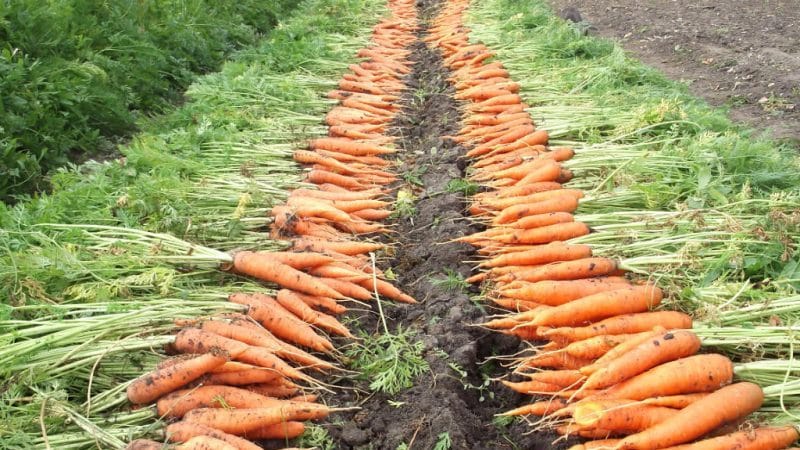
For beginning summer residents, varieties and hybrids are suitable that do not require special care, are resistant to fungal diseases, with high yields and excellent taste. Their characteristics are presented in the table.
| Name | Ripening period, days | Weight, g | Length, cm | Coloring | Form | Productivity, c/ha |
| Canada F1 | 90-110 | 130–170 | 18-22 | Dark orange | Semiconical | 301-628 |
| Shantanay royal | 90-110 | 110-180 | 15-17 | Orange | Conical | 290-507 |
| Nantes 4 | 80-120 | 90-160 | 12-16 | Orange | Cylindrical | 262-305 |
| Vitamin 6 | 100-110 | 70-90 | 17-20 | Orange | Cylindrical | 199-491 |
| Samson | 110-115 | 160-200 | 18-20 | Orange | Cylindrical | 528-762 |
| Queen of Autumn | 120-130 | 85-230 | 18-23 | Orange | Cone-shaped | 265-576 |
| Winter nectar | 80-90 | 85-130 | 18-20 | Orange | Elongated conical | 228-376 |
| Sugar caramel | 80-95 | 130-260 | 17-18 | Creamy white | Elongated conical | 528-762 |
Sowing dates
Sowing carrots depends on the growing region and the desired timing of the harvest.
To harvest early carrots in June - July, sowing work begins in mid-April and ends in early May. In August, carrots that have reached full ripeness are harvested.
Summer sowing is planned for mid-May - early June. These carrots are suitable for winter storage.
To harvest young carrots in the fall, the seeds are sown in mid-July.
Pre-winter sowing is carried out from October 20 to November 15. Root crops are harvested in early summer. For planting, choose areas with light sandy loam soil and early melting of snow. The seeds are disinfected in a solution of potassium permanganate, dried and immediately sown. In spring they swell and germinate quickly.
Sowing dates by region of Russia:
- in the middle zone (Moscow region) - late April - early May;
- in the Urals, North-West, Siberia - May;
- in the south - the second ten days of March - early April.
Selecting a location
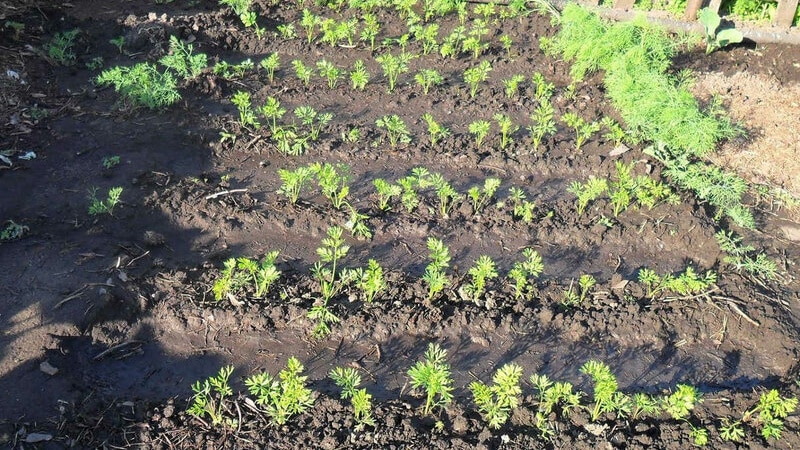
An important rule for successfully growing carrots is maintaining crop rotation. It is better to plant the crop after tomatoes, onions, cucumbers, potatoes, cabbage, and garlic.
It is not recommended to plant carrots after dill, parsley, celery, and parsnips - fungi and bacteria accumulate in the soil and attack root crops.
An area located on the sunny side of the garden is allocated for beds. The soil should be loamy, nutritious, with a neutral pH = 6.5-7 units. In heavy clay soil, root crops do not germinate well and become deformed.
Preparing the beds
The area for planting carrots is prepared in the fall and spring: it is plowed, compost and humus are added, loosened and leveled.
Acidic soil is deoxidized with ash, slaked lime or dolomite flour - 400-500 g per 1 m².Then the area is dug up.
The land is fertilized with organic matter (except for fresh manure) and complex additives with potassium and phosphorus: 10 liters of peat, 5 liters of humus, 30-40 g of superphosphate are added per 1 m².
Seed preparation
Carrot seeds contain essential oils that hinder the access of moisture to the embryo and their further germination. Pre-sowing soaking in water and growth stimulants will help increase the percentage of germination. Prepared seeds germinate in 4-6 days, unprepared seeds germinate in 15-20 days.
Methods of pre-sowing treatment of planting material:
- 7-10 days before sowing, place the seeds in a linen bag and bury them in the ground to the depth of a spade bayonet. On the day of sowing, dig up a bag and dry the seeds until they flow for 30-60 minutes. The advantage of the method is that the seeds increase in size, easily absorb moisture and sprout in 4-5 days.
- Bubbling - a method of processing seed material, which involves soaking in water at a temperature of +25...+27°C and saturating it with oxygen using a special device. The duration of the procedure is 24 hours. Next, the seeds are wrapped in cloth and placed in the refrigerator for 3-5 days. Then the seeds are dried until they flow.
- Pelleting - This is the covering of seeds with a shell 3-5 days before sowing. To do this, take 200 ml of liquid mullein, 200 g of powdered peat, 200 g of humus and mix in a deep container. 2 tsp. seeds are poured into a 1 liter jar, add 2 tbsp. l. nutrient mixture, close the container with a plastic lid and shake vigorously for 2-3 minutes. Then add another 1 tbsp. l. mixture and shake again. After the grains are coated, they are poured onto paper and dried.
- Soak in a nutrient solution based on sodium humate, “Effekton-O” (1 tsp.per 1 liter of water +30°C) or wood ash (1 tbsp per 1 liter of water +30°C). The seeds are placed in a fabric bag and immersed in the solution for 24 hours. Then they are washed with clean water, placed in damp gauze and placed in the refrigerator for 3-5 days. Before sowing, the material is dried until it flows.
A common mistake novice gardeners make is sowing seeds without checking for germination. How to do it? 30-45 days before sowing, the material is soaked in salted water (1 tsp per 200 ml) and left for half an hour. The seeds that float up are thrown away, those remaining at the bottom are used for sowing.
Landing instructions
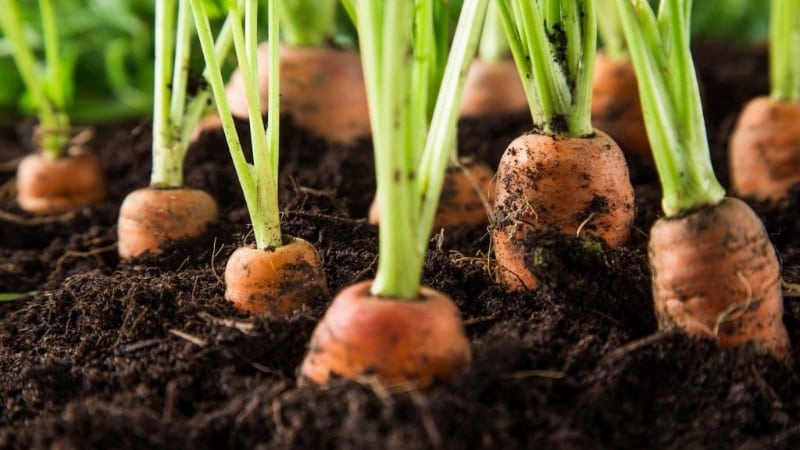
Beds for carrots are formed 90-100 cm wide, 15-20 cm high. In areas with close groundwater, the height is increased to 35 cm. The length of the beds can be arbitrary and depends on the needs of the summer resident for crops and the area of the plot. It is recommended to install wooden sides to prevent water from draining and washing away the beds when watering.
Furrows with a depth of 2 cm are formed on the site, maintaining a gap of 20 cm. Seeds are planted at intervals of 2-4 cm. The furrows are first shed with clean water, the seeds are mixed with sand to weigh them down. After sowing, the beds are mulched with humus, compost, vermicompost, and peat. This procedure prevents the spread of carrot flies, which lay eggs in the top layer of soil.
Important! The place where carrots are sown is not watered until sprouts appear to avoid washing out the seeds.
To retain moisture in the soil, plantings are covered with plastic film, and after germination it is removed.
There is another popular method of planting carrots - sowing in narrow rows using the Jacob Mittlider method. Such beds differ significantly from standard ones with raised side sides and wide aisles.High beds protect seeds from gusty winds and weeds and look neat in appearance.
The procedure for arranging beds:
- Borders are marked with wooden pegs. The optimal width is 45-50 cm, the length is arbitrary. The width of the passages is 1 m.
- Wooden boards are nailed along the perimeter, forming sides 10 cm high and 5 cm wide.
- The row spaces are covered with gravel or compacted to prevent the growth of weeds and the appearance of moles.
Place the beds in the direction from east to west for better lighting.
Further care
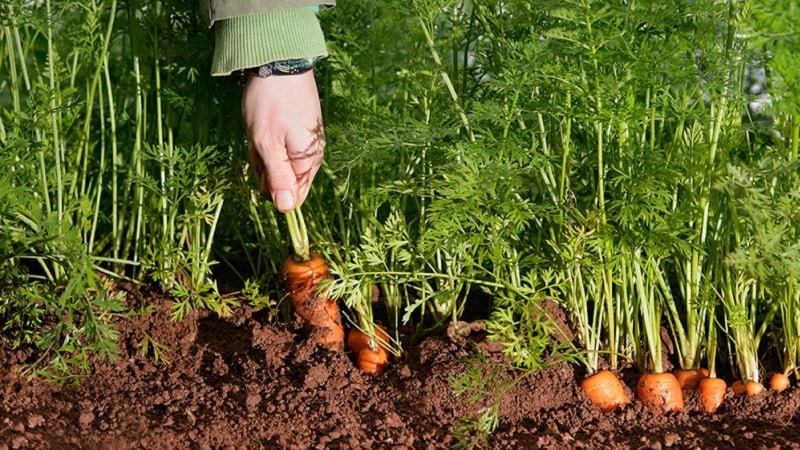
Rules for caring for carrot plantings:
- Regular loosening of the earthen crust after each watering and rain. To minimize labor costs, the beds are covered with mulch.
- Thinning the crops after the appearance of 2-3 true leaves. The optimal gap between sprouts is 3-4 cm. The procedure is repeated after 2 weeks, leaving a distance of 4-5 cm. First, the soil is moistened, then the greens are pulled out without loosening, so as not to damage the main root of the neighboring plant, otherwise lateral roots will appear and the root crop will grow ugly shape. Holes in the ground are filled and compacted.
- Hilling is carried out as the root crops grow, sprinkling the tops with earth. The bare areas turn green and solanine is formed in them, which gives the carrots bitterness.
- Moderate watering. Root crops form at the end of the growing season and do not tolerate excess moisture well, becoming covered with cracks. In drought, the beds are watered 3 times a week, in moderate weather - 1-2 times every 7 days. Watering rate is 4 liters per 1 m². As the root crops grow, water consumption is increased to 8-10 liters per 1 m².
Plantings are fertilized 2-3 times per season:
- I fertilizing - a month after full germination: 25 g of “Nitrophoska” per 10 liters of water.
- Second feeding - 15 days after the first: 1 liter of wood ash per 10 liters of water.
- III foliar feeding - in early August: 10 g of boric acid per 10 liters of water.
Diseases and pests

The plant is most often attacked by the carrot fly. The main signs of damage are curled, limp tops and larvae in root crops. The first wave of flies appears during the flowering period of rowan and apple trees, the second - at the end of June - beginning of July, when root crops are formed.
For prevention, onions, marigolds, cilantro, and garlic are sown next to carrots. The plants have a strong odor that repels insects.
The most effective way to prevent the spread of the pest is to mulch the beds with peat or sawdust in a layer of up to 5 cm or agrofibre. The mulch layer is constantly updated. A more expensive, but no less effective way to protect plantings is to cover them with lutrasil or spunbond.
If infection cannot be avoided, the tops are sprayed with chemicals “Actellik”, “Karbofos”, “Inta-vir”.
The biological product “Fitoverm” has a more gentle effect. To prepare a working solution, 10 ml of the drug is diluted in 5 liters of water. This amount is enough to process 10 m².
For those who prefer means that are safe for humans and the environment, there are traditional methods of pest control:
- Mix 100 g of tobacco dust, 50 g of slaked lime, 100 ml of water and add to the soil at the rate of 10 g of mixture per 1 m². Carry out the treatment 2-3 times every 10 days.
- Grind 3 kg of tomato tops, put in a barrel or bucket, pour boiling water to the top, leave for 48 hours, mix in 50 g of soap shavings and spray the plants 1-2 times a week.
- Pour 1 kg of yarrow into 10 liters of water, leave for 3-4 days, use for watering beds. Consumption rate - 1 bucket per 3 m².
- Chop the head of garlic and add 1 liter of water, leave for 4-5 days, add 50 g of soap shavings. Before watering, dilute with water 1:2.
- Pour 200 g of pine needles into 10 liters of water, leave for 24 hours, strain, pour into a container with a spray bottle and treat the carrots.
If you follow the rules of crop rotation, timely removal of weeds and disinfection of seeds before sowing, infectious diseases rarely occur. The most common are Alternaria ("black leg"), brown rot (Phomosis), and rhizoctonia (felt disease). They can be easily prevented by watering the beds before sowing with a 1% solution of Bordeaux mixture, copper sulfate or potassium permanganate, adding slaked lime.
Harvest and storage
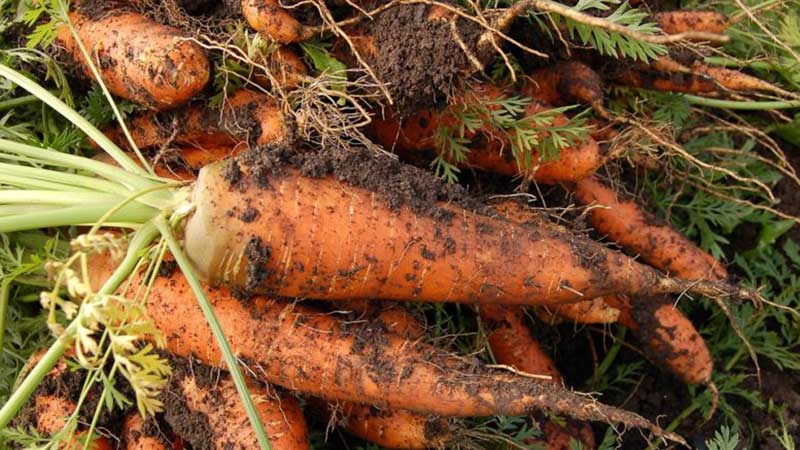
Root vegetables that have reached milky ripeness are removed from the soil for fresh consumption. This unscheduled thinning creates more room for the remaining carrots in the ground to grow and feed.
Further harvesting depends on the variety. Early carrots are harvested in July, mid-season carrots in August, late carrots in the second half of September - the first half of October.
It is advisable to collect root vegetables before the onset of the first frost. Frozen carrots do not store well and rot.
From light soil, root crops are pulled out by the tops, from dense soil they are dug with a shovel. Excess soil is shaken off, vegetables are sorted: whole ones are sent for storage, damaged ones are sent for processing, sick ones are thrown away.
The tops are cut to the head, the roots are dried under a canopy for 4-6 days and placed in wooden or plastic boxes in layers, sprinkled with wet river sand, onion peels, crushed chalk or covered with moss. The harvest is stored in cellar at a temperature of –2…+2°С and air humidity of 90-95%.
Glazing is an original way to store carrots.A mixture is prepared from clay and water, achieving the consistency of thick sour cream, carrots are dipped into it and placed on a wire rack to dry. The clay shell retains moisture inside the root crop and prevents rotting. Optimal temperature storage — 0…+2°С. The storage must be dry.
Advice from experienced summer residents
Properly prepare the site, seed material and grow rich harvest Advice from experienced gardeners will help you with carrots:
- When planting a crop after cucumbers, add 1-1.5 kg of mullein and 5 kg of crushed corn leaves to the soil.
- At growing vegetables on black soil, add 1 kg of river sand per 1 m² for loosening and additional aeration.
- Follow the rules of crop rotation: plant carrots in the same place no earlier than 3-4 years later, avoid planting after umbrella crops. Carrots grow best after potatoes, tomatoes and cabbage.
- Mix carrot seeds with lettuce or radish seeds. These crops grow faster than carrots and help to mark an area with crops for surface loosening of the beds. By pulling the radishes out of the ground, you will be thinning the carrots at the same time.
- To prevent carrot fly infestation, plant carrots next to onions and garlic.
- To distribute the seeds evenly in the furrows, mix them with a paste of water and flour.
- Avoid stagnant water in the beds to prevent the spread of fungal diseases.
Conclusion
To grow large, juicy and healthy carrots, it is important to follow the technology: crop rotation, choosing a site on the south side of the garden, normalizing the acidity and increasing the nutritional value of the soil, pre-sowing seed treatment, loosening the soil crust, weeding, thinning, hilling the beds, moderate watering and adding organic matter. and mineral supplements.
Avoid using fresh manure to fertilize the soil to prevent root crops from growing bearded. Follow the sowing dates, they are different for each region. Harvest carrots before frost to prevent rotting during storage.